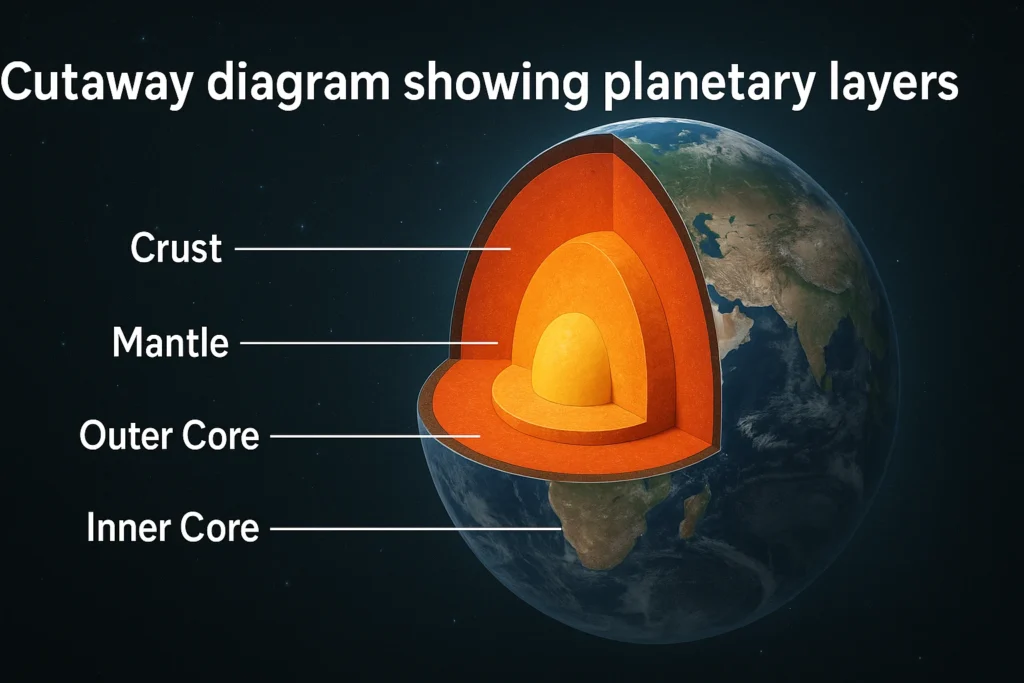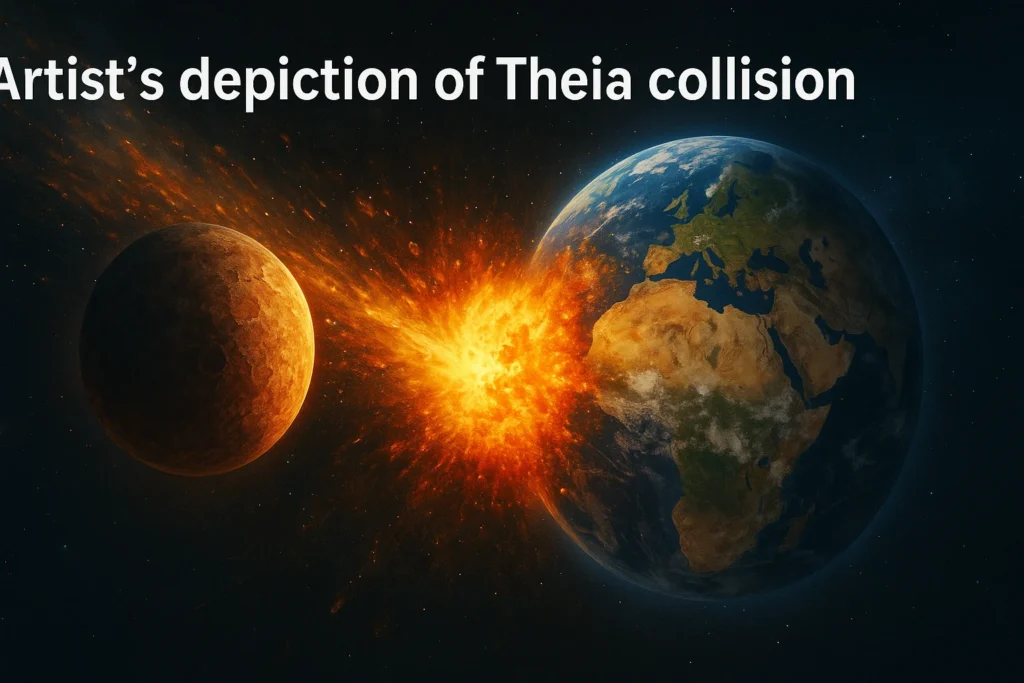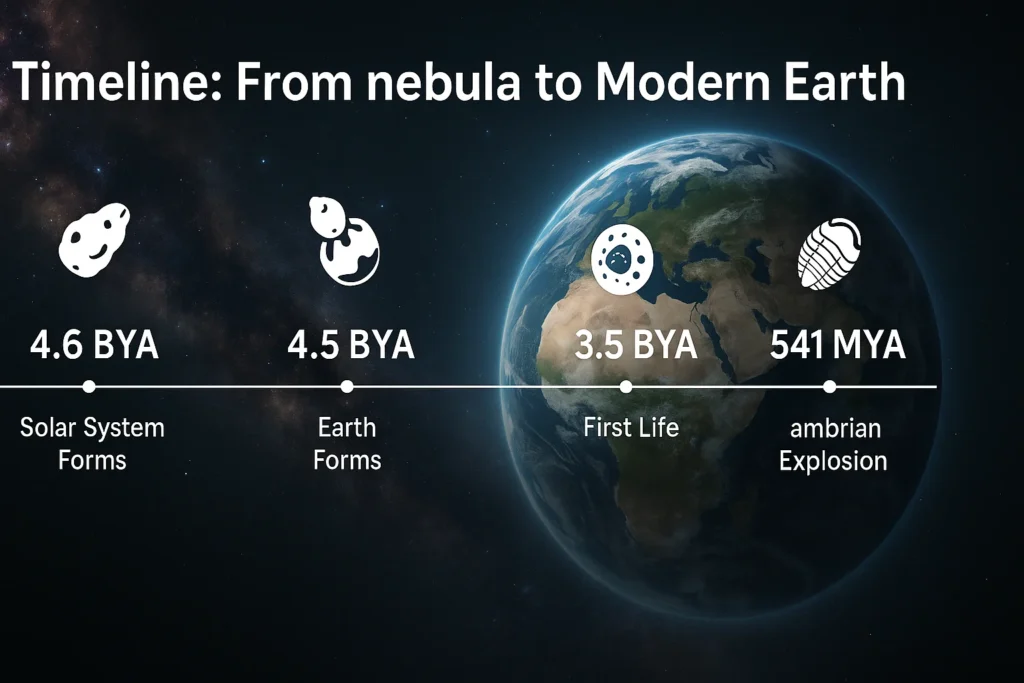A Violent Cosmic Beginning
In a forgotten corner of the Milky Way, a dying star’s final act—a supernova explosion—sent shockwaves through a molecular cloud 4.6 billion years ago. This cosmic detonation compressed stardust and gas into a swirling disk where our solar system would emerge. At its center, an unremarkable yellow star began fusing hydrogen. Around it, microscopic mineral grains collided, stuck together, and eventually formed the world we call home—though it bore no resemblance to the Earth we know today.
The Making of a Planet: Step by Step
Stage 1: The Solar Nebula (4.6 BYA)
- Ingredients: 99% gas (hydrogen/helium), 1% stardust (silicon, iron, carbon)
- Key Process: Chondrules (molten droplets) formed first building blocks
- Temperature: 1,500°C near Sun, -200°C in outer reaches
Surprising Fact: Earth contains gold worth $1 quadrillion—all from ancient neutron star collisions.
Stage 2: Planetary Embryos Collide (4.5 BYA)
| Impact Event | Consequence |
|---|---|
| Theia collision | Created the Moon |
| Late Heavy Bombardment | Delivered Earth’s water |
| Core formation | Generated magnetic field |
“Imagine millions of atomic bombs exploding every second for 100 million years—that was Earth’s childhood.”
— Dr. Sarah Stewart, Planetary Scientist

Stage 3: The Hellish Hadean Eon (4.4 BYA)
- Surface: Magma ocean 1,000 km deep
- Atmosphere: Toxic mix of methane, ammonia, and sulfur
- Day Length: 6 hours (before Moon slowed rotation)
2024 Discovery: Zircon crystals prove liquid water existed just 100 million years after formation.
The Moon’s Dramatic Birth
Giant Impact Hypothesis
- When: 4.5 BYA
- What: Mars-sized protoplanet Theia sideswipes Earth
- Result:
- Debris forms Moon in just 1 month
- Earth gains 23° tilt (causing seasons)
- 20% of Earth’s mass lost
New Evidence: Moon rocks contain isotopes identical to Earth’s mantle—supporting the theory.

Earth’s Great Transformation
Cooling & Layering (4 BYA)
- Iron Catastrophe: Molten iron sinks to form core
- Crust Formation: Light minerals float to surface
- Mantle Convection: Engine driving plate tectonics
Current Composition:
- Crust: 1% of volume (like an apple’s skin)
- Mantle: 84% (solid but flowing)
- Core: 15% (liquid outer, solid inner)
Water World Emerges (3.8 BYA)
- Source: Icy comets + volcanic outgassing
- First Oceans: 3x saltier than today
- Game Changer: Water enables plate tectonics
The Solar System’s Protective Shield
Earth’s Life-Saving Features
- Magnetic Field: Generated by spinning liquid iron core
- Ozone Layer: Formed when oxygen hit UV light
- Moon’s Role: Stabilizes axial tilt (prevents climate chaos)
Cosmic Luck: Jupiter’s gravity deflects asteroids while allowing comets through.
Key Unsolved Mysteries
1. Where Did Earth’s Water Really Come From?
- New studies suggest more from mantle outgassing than comets
2. Why Does Earth Have Active Plate Tectonics?
- Venus, nearly Earth’s twin, has none
3. How Did Life Survive Late Heavy Bombardment?
- 500-million-year asteroid rain should have sterilized planet
Earth’s Future: 5 Billion Years Ahead
Coming Attractions
- 1 BY: Sun’s heat boils oceans
- 3 BY: Plate tectonics stop
- 5 BY: Sun becomes red giant, swallows Earth
Human Legacy: If civilization lasts, we’ll need to move planets long before then.
Key Takeaways
☄️ Built from supernova debris in a cosmic construction project
🌑 Moon formed in most violent event in Earth’s history
♨️ First 700 million years were molten hellscape
🌊 Water arrived via celestial deliveries
🧲 Magnetic field is our invisible life shield
FAQ
Q: How do we know Earth’s age?
A: Uranium-lead dating of meteorites gives 4.54±0.05 billion years.
Q: Could Earth have had rings?
A: Briefly after Theia impact—debris coalesced into the Moon.
Q: What’s the oldest Earth material?
A: Zircons from Australia dated at 4.4 billion years.
Q: Is Earth still gaining mass?
A: Yes—40,000 tons/year from cosmic dust, but losing hydrogen too.
The story of Earth reminds us we’re riding through space on a cosmic artifact—one forged in violence, shaped by chance, and perfected over eons. As we search for other habitable worlds, we’re only beginning to appreciate how many miracles had to align to make our pale blue dot possible. Every atom in your body was once part of this extraordinary journey—the ultimate inheritance from a universe that somehow became aware of itself.



